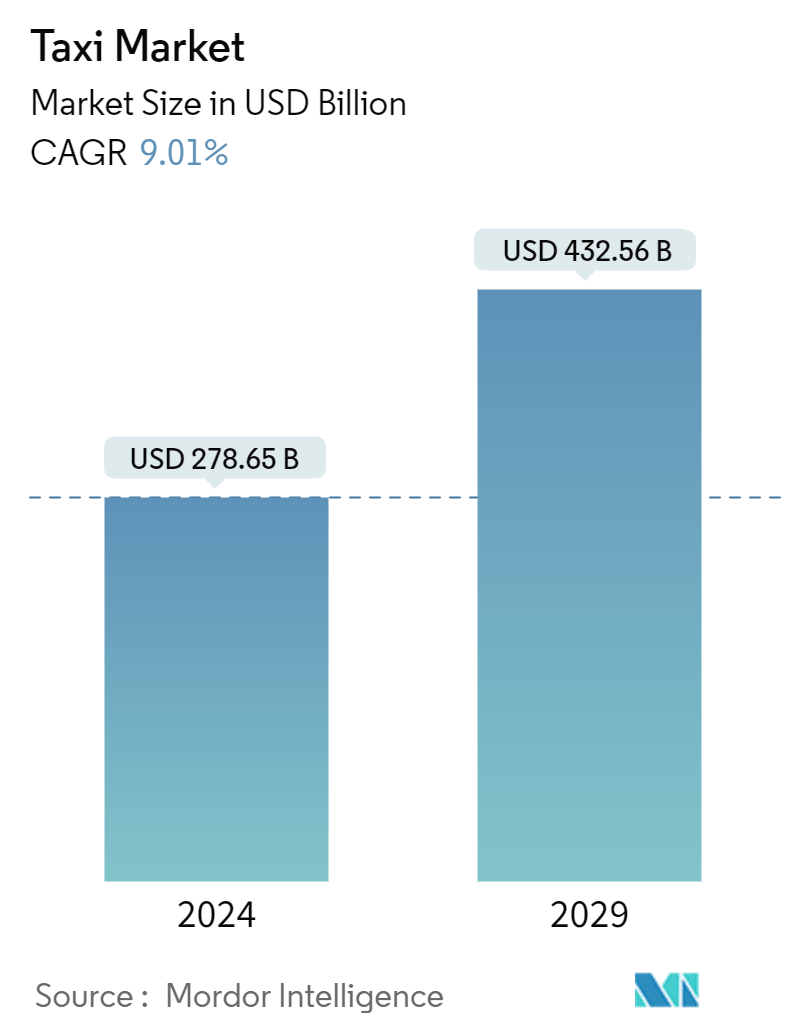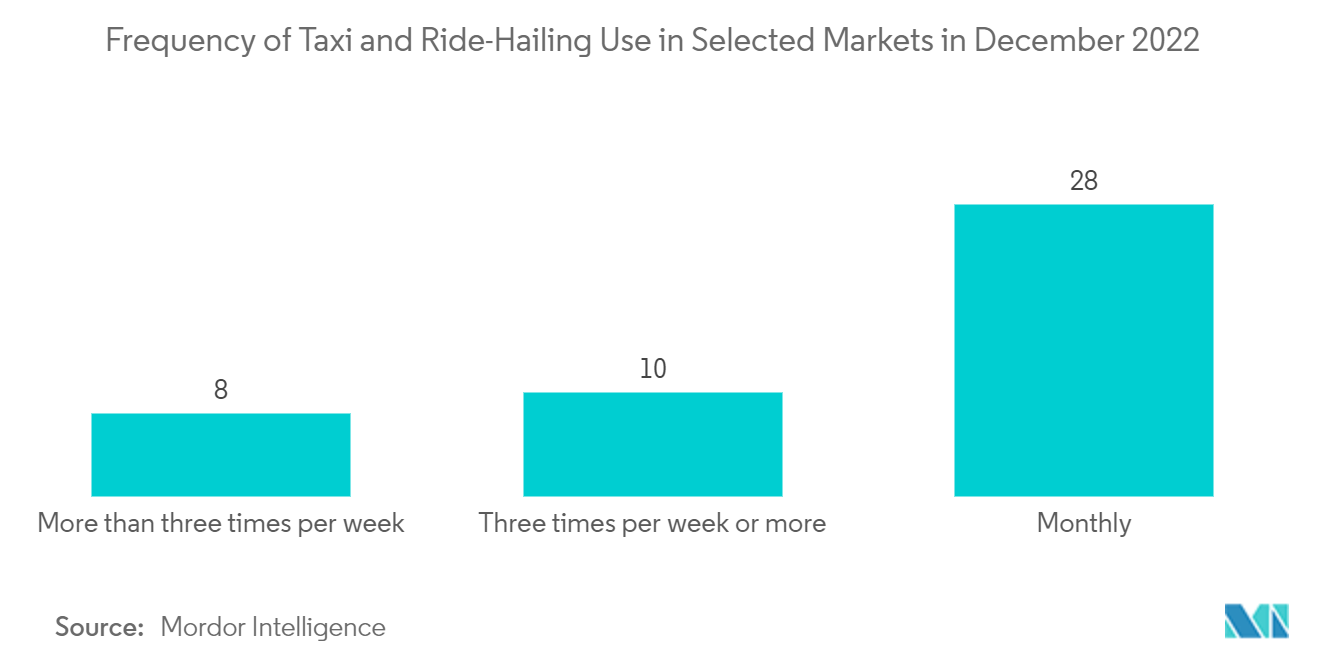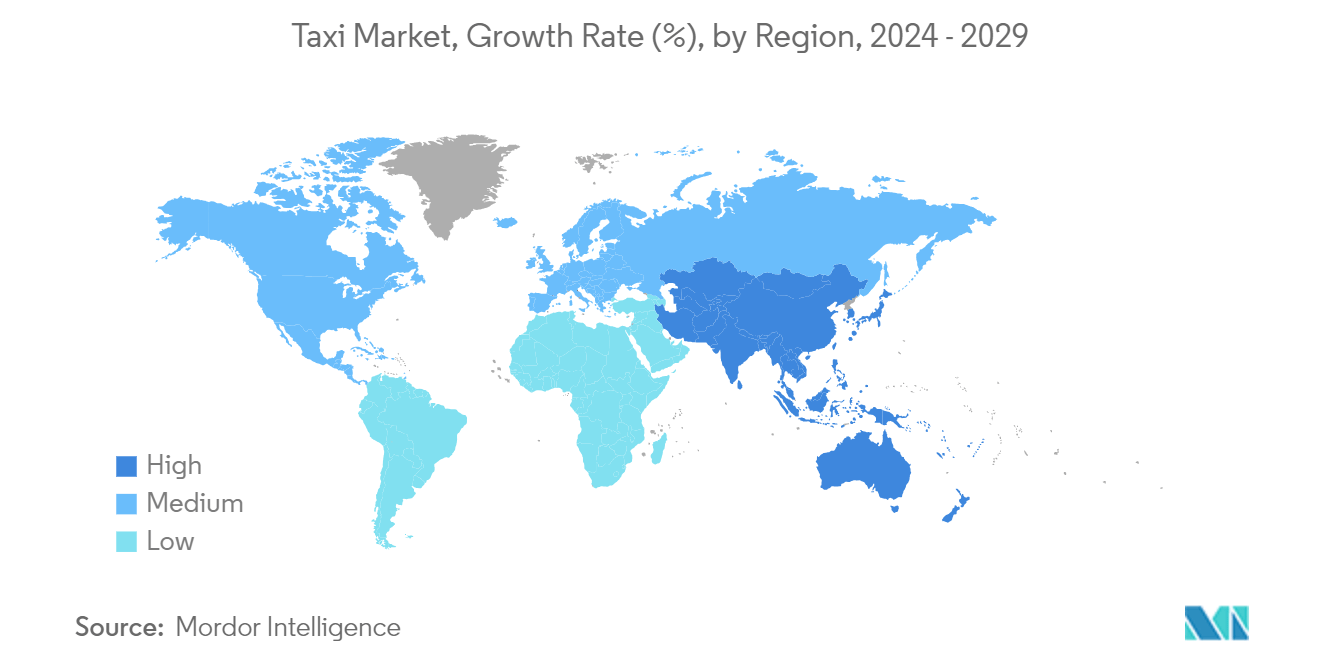Taxi Market Size

| Study Period | 2019 - 2029 |
| Market Size (2024) | USD 278.65 Billion |
| Market Size (2029) | USD 432.56 Billion |
| CAGR (2024 - 2029) | 9.01 % |
| Fastest Growing Market | Asia Pacific |
| Largest Market | Asia Pacific |
Major Players
*Disclaimer: Major Players sorted in no particular order |
Taxi Market Analysis
The Taxi Market size is estimated at USD 278.65 billion in 2024, and is expected to reach USD 432.56 billion by 2029, growing at a CAGR of 9.01% during the forecast period (2024-2029).
The taxi market has undergone substantial transformations in recent years, influenced by technological advancements, changing consumer preferences, and evolving regulatory landscapes. Taxis, once primarily hailed on the streets, have witnessed a significant shift toward app-based ride-hailing services. Companies like Uber, Lyft, and Didi Chuxing have disrupted traditional taxi models, introducing convenient and efficient ways for passengers to book rides using mobile applications.
The emergence of ride-hailing services has been a game-changer in the taxi industry. These services connect passengers with drivers through smartphone apps, offering benefits such as real-time tracking, cashless payments, and user ratings. The convenience and transparency provided by these platforms have contributed to their widespread adoption, challenging the traditional taxi dispatch system. However, this shift has also sparked debates regarding fair competition, driver rights, and regulatory concerns in various regions.
With a growing emphasis on sustainability, the taxi market is experiencing a shift toward electric vehicles (EVs). Many taxi operators and ride-hailing companies are incorporating electric or hybrid vehicles into their fleets to reduce carbon emissions and promote environmentally friendly transportation. Government incentives and regulations aimed at curbing air pollution further encourage the adoption of electric taxis, marking a significant step towards a more sustainable taxi industry.
Over the long term, the taxi industry is expected to grow due to increasing demand for ride-hailing and ride-sharing services, increasing demand from online taxi booking channels, and an increase in the cost of vehicle ownership. Compared to other modes of transportation, increasing traffic congestion and low taxi fares are the other major factors driving the taxi market.
However, the development of the industry is hampered by improvements in public transit and differing government laws on taxi services in different nations worldwide. The rise of eco-friendly electric cab services is likely to provide an attractive potential for market expansion between 2024 and 2029.
Asia-Pacific is expected to witness a considerable growth rate in the target market. This is due to the fact that the region is home to 60% of the world's population, with India and China contributing significantly to the region having the highest working population in the world.
Taxi Market Trends
Online Bookings are Driving the Market
One of the primary factors fueling the market's growth is the increased usage of online cab booking platforms, mostly because of the convenience they provide to clients. They also offer simple online payment options and the flexibility of choosing the pick-up and drop-off locations.
The ease of booking through the app has significantly attracted customers to prefer online booking over offline booking, owing to the increasing penetration of the internet and smartphones worldwide. Additionally, the availability of information on an app, like tracking the driver position, pre-estimated ride fare, driver contact, and vehicle details, has further increased the customer preference for online booking.
Many major operators, such as Grab, Uber, and Ola, provide ride-sharing options (which offer a fare-splitting option among co-passengers) in certain regions, capturing the increasing demand for low taxi fare services among customers. Operators are adopting the same strategy and incorporating the ride-sharing option in their app development to sustain the growing trend of ride-sharing services.
- For instance, in Vietnam, Mai Linh, one of the country's major taxi operators, focuses on providing ride-sharing services to overcome the country's mobility challenges, like traffic congestion and population. The company partnered with Kyyti Group to launch a ride-sharing service in Vietnam in the future.
However, with the surge in demand for online taxis, governments are implementing strict guidelines for taxi aggregators to regulate their prices. For instance,
- In January 2024, the Karnataka government implemented standardized fares for online taxi services such as Ola and Uber, as well as other taxi services operating within the state. This initiative is designed to tackle prevalent issues of overcharging in city taxi services and establish a consistent fare system across the board.

Asia-Pacific is Expected to Grow at a Significant Pace in the Taxi Market
Asia-Pacific has been dominating the taxi industry, accounting for about half of the taxi market. Key elements fueling the rise of motorcycle/bike ride-hailing services in Asia-Pacific are increasing traffic congestion and inexpensive taxi fares compared to other means of transportation. As the region is home to 60% of the world's population, its ride-hailing industry is substantial and developing rapidly.
In Asia-Pacific, the taxi industry is expanding rapidly. Players like DiDi Chuxing, Ola, and Onda are capitalizing on Asia-Pacific's high smartphone penetration rate. They are gaining market share by utilizing cutting-edge technology and innovation. Major South Asian cab service providers are increasing the competition in regional marketplaces while growing internationally. Didi Chuxing, a Chinese taxi company, launched operations in Mexico, Australia, Costa Rica, Japan, and several other countries. Ola, the Indian market leader, operates in Australia, New Zealand, and the United Kingdom.
China has the world's largest taxi market as it is the most populous country. Taxis gradually became a necessary service due to their flexibility, comfort, high availability, and end-mile connection.
India also has a huge taxi market after China. The taxi industry is changing continuously (even every quarter) due to the different socio-economic and political situations arising in the country. Pooling/sharing of taxis in the country saw huge demand. Bike taxis are also gaining popularity in the Indian market.
- In 2023, Rapido officially announced its entry into the cab aggregation space with the launch of ‘Rapido Cabs.’ The company already provides bike taxis and auto (three-wheeler) passengers to its customers. The addition of a cab service brings Rapido closer to competition with market leaders Ola and Uber. EV-based BluSmart and InDrive are also trying to tap into the market but have a relatively smaller presence in the market.
With a high demand for cabs, especially in tier one and metro cities, the online cab market is changing with the entry of bike taxis into the market, which are much more affordable than cabs and provide easy maneuvering in traffic congestion. Thus, the bike taxi market is expected to grow rapidly in the coming years.

Taxi Industry Overview
Some of the major players in the taxi market are Uber, Grab, Lyft, and Ola. Uber's main strategy for expanding its business is to focus on upcoming technologies like automated driving vehicles.
- Turkey's urban mobility landscape is undergoing a significant transformation, as evidenced by the latest strategic move by Marti Technologies Inc. In February 2024, the company, renowned for its comprehensive range of transportation services, introduced a taxi-hailing feature in Istanbul, signaling a new phase in its efforts to streamline urban transit.
- The 7th Avenue Taxi Rank Association unveiled an innovative cashless payment system on Friday, 1 March, a notable advancement in local public transportation.
- Key players in the industry are investing hugely in technology. Uber and DiDi Chuxing are working on self-driving cars to enhance the customer experience. In India, there has been a surge in the number of customers opting for outstation services. Thus, Ola, Meru, and Prydo are offering value-added services to their customers at very competitive prices. Ola partnered with Apple Music and other music and video streaming services for its Prime Play service.
Taxi Market Leaders
-
Uber Technologies Inc.
-
Lyft Inc.
-
Didi Chuxing
-
GrabTaxi Holdings Pte Ltd
-
ANI Technologies Pvt. Ltd (Ola)
*Disclaimer: Major Players sorted in no particular order

Taxi Market News
- March 2024: After successfully launching services in Vientiane's Capital and the popular tourist destination of Vang Vieng, Xanh SM Laos officially extended its electric taxi operations to Savannakhet Province. This expansion not only signifies the next phase in Xanh SM's brand development but also underscores the company's ongoing dedication to the promotion of electric vehicles.
- March 2024: Waymo secured approval on Friday from California regulators for offering paid robotaxi rides in the second-largest city in the United States, as well as expanding its services in more areas of the San Francisco Bay Area.
- January 2024: Baayu, positioned as India’s inaugural app-based 100% electric and decentralized bike taxi service, was launched as a collaborative effort between the state government-run Assam State Transport Corporation and a startup company.
Taxi Market Report - Table of Contents
1. INTRODUCTION
- 1.1 Study Assumptions
- 1.2 Scope of the Study
2. RESEARCH METHODOLOGY
3. EXECUTIVE SUMMARY
4. MARKET DYNAMICS
- 4.1 Market Drivers
- 4.2 Market Restraints
-
4.3 Industry Attractiveness - Porter's Five Forces Analysis
- 4.3.1 Threat of New Entrants
- 4.3.2 Bargaining Power of Buyers/Consumers
- 4.3.3 Bargaining Power of Suppliers
- 4.3.4 Threat of Substitute Products
- 4.3.5 Intensity of Competitive Rivalry
5. MARKET SEGMENTATION
-
5.1 Booking Type
- 5.1.1 Online Booking
- 5.1.2 Offline Booking
-
5.2 Service Type
- 5.2.1 Ride-hailing
- 5.2.2 Ride-sharing
-
5.3 Vehicle Type
- 5.3.1 Motorcycle
- 5.3.2 Cars
- 5.3.3 Other Vehicle Types (Vans)
-
5.4 Geography
- 5.4.1 North America
- 5.4.1.1 United States
- 5.4.1.2 Canada
- 5.4.1.3 Rest of North America
- 5.4.2 Europe
- 5.4.2.1 Germany
- 5.4.2.2 United Kingdom
- 5.4.2.3 France
- 5.4.2.4 Spain
- 5.4.2.5 Rest of Europe
- 5.4.3 Asia-Pacific
- 5.4.3.1 China
- 5.4.3.2 India
- 5.4.3.3 Japan
- 5.4.3.4 Australia
- 5.4.3.5 Vietnam
- 5.4.3.6 South Korea
- 5.4.3.7 Rest of Asia-Pacific
- 5.4.4 Rest of the World
- 5.4.4.1 Mexico
- 5.4.4.2 Brazil
- 5.4.4.3 South Africa
- 5.4.4.4 Argentina
- 5.4.4.5 Other Countries
6. COMPETITIVE LANDSCAPE
- 6.1 Vendor Market Share
-
6.2 Company Profiles
- 6.2.1 ANI Technologies Pvt. Ltd (Ola)
- 6.2.2 BlaBlaCar
- 6.2.3 Bolt Technologies OU
- 6.2.4 Curb Mobility LLC
- 6.2.5 (Didi Chuxing) Beijing Xiaoju Technology Co. Ltd
- 6.2.6 Flywheel Software Inc.
- 6.2.7 Gojek Tech
- 6.2.8 Grab Holdings Inc.
- 6.2.9 FREE NOW
- 6.2.10 Kabbee Exchange Limited
- 6.2.11 Lyft Inc.
- 6.2.12 Uber Technologies Inc.
- *List Not Exhaustive
7. MARKET OPPORTUNITIES AND FUTURE TRENDS
** Subject To AvailablityTaxi Industry Segmentation
Taxis are a type of vehicle leasing service that includes the hiring of a driver and the vehicle. It can be used by single or multiple passengers, with the option of sharing or not sharing.
The taxi market is segmented by booking type, vehicle type, service type, and geography.
By booking type, the market is segmented into online booking and offline booking. By vehicle type, the market is segmented into motorcycles, cars, and other vehicle types (vans). By service type, the market is segmented into ride-hailing and ride-sharing.
By geography, the market is segmented into North America, Europe, Asia-Pacific, and Rest of the World. The report covers the market size and forecasts the value (USD Billion) for all the above segments.
| Booking Type | Online Booking | |
| Offline Booking | ||
| Service Type | Ride-hailing | |
| Ride-sharing | ||
| Vehicle Type | Motorcycle | |
| Cars | ||
| Other Vehicle Types (Vans) | ||
| Geography | North America | United States |
| Canada | ||
| Rest of North America | ||
| Geography | Europe | Germany |
| United Kingdom | ||
| France | ||
| Spain | ||
| Rest of Europe | ||
| Geography | Asia-Pacific | China |
| India | ||
| Japan | ||
| Australia | ||
| Vietnam | ||
| South Korea | ||
| Rest of Asia-Pacific | ||
| Geography | Rest of the World | Mexico |
| Brazil | ||
| South Africa | ||
| Argentina | ||
| Other Countries |
Taxi Market Research FAQs
How big is the Taxi Market?
The Taxi Market size is expected to reach USD 278.65 billion in 2024 and grow at a CAGR of 9.01% to reach USD 432.56 billion by 2029.
What is the current Taxi Market size?
In 2024, the Taxi Market size is expected to reach USD 278.65 billion.
Who are the key players in Taxi Market?
Uber Technologies Inc., Lyft Inc., Didi Chuxing, GrabTaxi Holdings Pte Ltd and ANI Technologies Pvt. Ltd (Ola) are the major companies operating in the Taxi Market.
Which is the fastest growing region in Taxi Market?
Asia Pacific is estimated to grow at the highest CAGR over the forecast period (2024-2029).
Which region has the biggest share in Taxi Market?
In 2024, the Asia Pacific accounts for the largest market share in Taxi Market.
What years does this Taxi Market cover, and what was the market size in 2023?
In 2023, the Taxi Market size was estimated at USD 253.54 billion. The report covers the Taxi Market historical market size for years: 2019, 2020, 2021, 2022 and 2023. The report also forecasts the Taxi Market size for years: 2024, 2025, 2026, 2027, 2028 and 2029.
What is the future of the Taxi Market?
Integration with technology, focus on personalization and sustainability, and potential partnerships between traditional and digital players are likely to be the future of the Taxi Market.
What is the fastest-growing segment in Taxi Market?
Ride-hailing apps are the fastest-growing segment due to convenience and digital accessibility.
Cab Industry Report
The global taxi market is experiencing significant growth driven by the rise in popularity of ride-hailing and ride-sharing services. This trend is largely attributed to the convenience of online booking platforms, which offer flexible pick-up and drop-off locations and seamless online payments. As vehicle ownership costs continue to rise, consumers are increasingly turning to taxis as a more economical option.
In terms of market segmentation, the market is categorized by booking type, service type, and vehicle type. Online booking and ride-sharing are emerging as the most promising sectors within the market. Despite challenges such as improved public transport and varying regulations across regions, the market is poised for growth. Innovations such as eco-friendly electric cabs and robo-taxis are expected to further drive this growth.
The Asia-Pacific region is projected to see notable growth due to its large population and rapid urbanization, which contribute to increased traffic and a higher demand for efficient taxi services. Globally, new business models and technological advancements are making taxi services more user-friendly.
The report provides a comprehensive industry analysis, including market size, industry statistics, and market share. It also offers insights into industry trends, market growth, and market value. The market forecast and industry outlook indicate a positive trajectory for the taxi market, supported by detailed market data and industry reports.
For those interested in a deeper dive, the report includes a market overview, market segmentation, and market predictions. It also highlights the performance of market leaders and provides a thorough market review. The report is available in PDF format and serves as an essential resource for understanding the industry's dynamics and future prospects.



